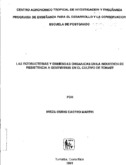| dc.contributor.advisor | Bustamante, E. | es_ES |
| dc.contributor.author | Castro Martín, M. O. | |
| dc.date.accessioned | 2021-03-04T15:18:17Z | |
| dc.date.available | 2021-03-04T15:18:17Z | |
| dc.date.issued | 1998 | |
| dc.identifier.uri | https://repositorio.catie.ac.cr/handle/11554/10385 | |
| dc.description | Tesis (Mag.Sc.) - CATIE, Turrialba (Costa Rica), 1998 | es_ES |
| dc.description.abstract | Se evaluó el efecto de cinco rizobacterias y dos enmiendas orgánicas en la promoción del crecimiento y en la inducción de resistencia sistémica contra geminivirus en plantas de tomate de dos variedades: Hayslip, susceptible al geminivirus y 8429 de resistencia intermedia. Se estableció un diseño completamente al azar con 12 tratamientos y cinco repeticiones para cada una de las dos variedades de tomate. Todos los tratamientos fueron inoculados con geminivirus a excepción del testigo absoluto (T12) el cual se mantuvo en invernadero; los demás tratamientos fueron evaluados en el campo semanalmente. El geminivirus fue inoculado en las plantas por medio del vector: Bemisia tabaci (Gennadius) manteniendo las microjaulas con cuatro moscas blancas adultas virulíferas en cada planta por cuatro días. La detección del geminivirus en las plantas se realizó por medio de la Reacción en Cadena de la Polimerasa (PCR). Las rizobacterias evaluadas en el experimento fueron dos de la colección MIP-CATIE: Bacillus cereus (Frankland y Frankland), Pseudomonas cepacia (Palleroni y Holmes) y tres aisladas de raíces de plantas de tomate colectadas en las comunidades de Guayabo (Cartago) y Grecia (Alajuela): Bacillus sp, Pseudomonas fluorescens y Pseudomonas sp. Las enmiendas orgánicas utilizadas fueron: Compost y bocashi. La inoculación de las rizobacterias se hizo por medio de bacterización a la semilla. Las variables evaluadas fueron: altura, severidad de la enfermedad y producción de biomasa. Los tratamientos con compost y bocashi más las rizobacterias resultaron ser los mayores promotores de crecimiento (altura y biomasa) en las dos variedades de tomate evaluadas. La inducción de resistencia sistémica en las plantas de la variedad Hayslip se dio con las enmiendas orgánicas y con el tratamiento que tenía compost más la mezcla de rizobacterias. Para la variedad de resistencia intermedia 8429 se dio con los tratamientos que tenían la enmienda orgánica más la mezcla de rizobacterias, además con los tratamientos: Bacillus cereus, Psudomonas cepacia y la mezcla de las cinco rizobacterias.
Five rhizobacterias and two organic amendments were evaluated for growth promotion and induced resistance agains geminivirus with two cultivars of tomato. The tomato cultivars were Hayslip, geminivirus susceptible and 8429, of moderate resistance. It was established with twelve treatments and five repetitions in a completely random design. All treatments were inoculated with geminivirus, except for the absolute control (T12); these last grown under greenhouse conditions. All other treatments were field evaluated weekly. Four adult virulent whiteflies were maintained in microcages on the plants for four days, used for the geminivirus transmission. Polymerase Chain Reaction (PCR) was used to detect the presence of geminivirus on inoculated tomato plants. The treatments consisted of the application of two different rhizobacteria strains from the MIP-CATIE collection: Bacillus cereus (Frankland and Frankland) and Pseudomonas cepacia (Palleroni and Holmes) and three other rhizobacteria isolated from the roots of tomato plants collected from the field: Bacillus sp., Pseudomonas fluorescens y Pseudomonas sp. Two organic amendments were used: Compost and Bocashi, and the rhizobacterias were seed inoculated. Plant height, biomas production and the disease severity of plants were evaluated. These treatments, with organic amendments and/or the application of the organic amendment plus the five rhizobacterias, promoted growth in both cultivates of tomatoes. The systemic resistance induction of Hayslip cultivars was achieved with the organic amendments and with the treatment that the compost had plus the five rhizobacterias. For the 8429 cultivars of moderate resistance the systemic induction was achieved through the treatments that the organic amendment had plus the five rhizobacterias, in addition to the treatments: Bacillus cereus, Pseudomonas cepacia and the mixture of the five rhizobacterias. | es_ES |
| dc.language.iso | es | es_ES |
| dc.publisher | Centro Agronómico Tropical de Investigación y Enseñanza (CATIE), Turrialba (Costa Rica) | es_ES |
| dc.rights | info:eu-repo/semantics/openAccess | es_ES |
| dc.subject | BACILLUS | |
| dc.subject | BACILLUS CEREUS | |
| dc.subject | BEMISIA TABACI | |
| dc.subject | CONTROL BIOLÓGICO DE PLAGAS | |
| dc.subject | CRECIMIENTO | |
| dc.subject | ENMIENDAS ORGÁNICAS | |
| dc.subject | GEMINIVIRUS | |
| dc.subject | INOCULACIÓN | |
| dc.subject | PRODUCCIÓN DE BIOMASA | |
| dc.subject | RESISTENCIA A LA ENFERMEDAD | |
| dc.title | Las rizobacterias y enmiendas orgánicas en la inducción de resistencia a geminivirus en el cultivo del tomate | es_ES |
| dc.title.alternative | The rhizobacterias and organic amendments in the induction of resistance a geminivirus in tomato plants | es_ES |
| dc.type | Tesis | es_ES |


